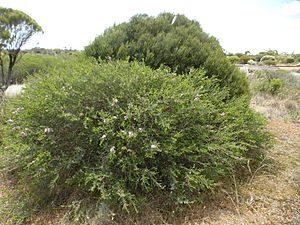Narrow-leaved paperbark facts for kids
Quick facts for kids Narrow-leaved paperbark |
|
|---|---|
 |
|
| M. laxiflora growing 13 km north of Corrigin | |
| Scientific classification | |
| Genus: |
Melaleuca
|
| Species: |
laxiflora
|
Melaleuca laxiflora, also known as narrow-leaved paperbark, is a type of woody shrub. It belongs to the myrtle family, called Myrtaceae. This plant only grows naturally in the south-west part of Western Australia. It's special because of its pink flowers that grow in loose spikes along its branches. Its leaves are smooth, a bit thick, and have tiny oil dots. Many people like to grow this plant in their gardens because it's tough and has pretty flowers.
Contents
What it Looks Like
Melaleuca laxiflora is a round, open shrub that can grow between 0.5 and 3 meters (about 1.5 to 10 feet) tall and wide. It has rough, stringy bark. Its leaves grow one after another along the stems. They are smooth (meaning they don't have hairs) and are shaped like a narrow oval or a tear-drop. These leaves are about 4.5 to 28 millimeters (0.2 to 1.1 inches) long and 1.5 to 4 millimeters (0.06 to 0.16 inches) wide. You can see small oil glands on them.
Flowers and Fruit
The flowers of this plant are usually mauve, pink, or purple, but sometimes they can be white. They grow in groups of 6 to 20 individual flowers along the sides of the branches. These flower groups are about 20 to 40 millimeters (0.8 to 1.6 inches) long and about 20 millimeters (0.8 inches) across. Inside each flower, there are five groups of stamens (the parts that make pollen), with 12 to 18 stamens in each group. Most flowers appear from October to December. After the flowers, the plant produces fruit in loose bunches. Each fruit is a cylinder-shaped capsule, about 3 to 5 millimeters (0.12 to 0.2 inches) long and 3 millimeters (0.12 inches) wide. The sepals (small leaf-like parts that protect the flower bud) stay on the fruit as small teeth around its edge.
Plant Names and History
The scientific name Melaleuca laxiflora was first officially described in 1852. This was done by a scientist named Nikolai Turczaninow. He wrote about it in a science publication from Saint-Petersburg.
Meaning of the Name
The second part of the plant's name, laxiflora, comes from two Latin words. Laxus means "loose" or "slack," and -florus means "flowered." This name describes how the individual flowers in each spike are spaced out, making the spike look "loose."
Where it Grows
This melaleuca plant is found in several areas of Western Australia. It grows from the Mollerin district down to the Ongerup and Norseman districts. These areas include the Avon Wheatbelt, Coolgardie, and Mallee regions. You can often find it growing in sandy or clay soils, especially where there is granite underneath, on flat lands and along roadsides.
Conservation Status
The Government of Western Australia's Department of Parks and Wildlife has listed Melaleuca laxiflora as "not threatened." This means that the plant is not currently in danger of disappearing.
Growing it in Gardens
This plant is often grown in gardens and is known to be quite tough. It grows best in a sunny spot where the soil drains well. It prefers places with semi-dry and mild climates rather than very humid areas.
Images for kids




